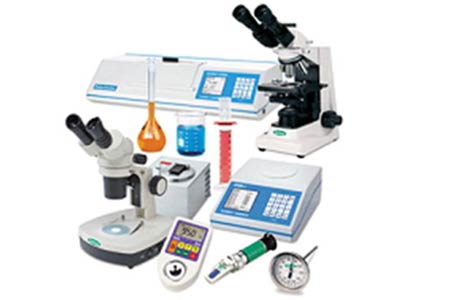- +91-8624883983
- info@insightsmicro.com
Laboratory Equipment : Global Trends, Facts and Figures

The global market for the laboratory equipment industry can be summarized in the following terms: it is greater than a particular market's share because it includes various types of devices for research purposes or diagnostics and control, both of which are essential in science and medicine. The major factors contributing to the market include increases in the biotechnological, pharmaceutical, and clinical diagnostics industries, as well as a continuously growing need for enhanced analytical devices in other industrial and academic fields of research.
The worldwide laboratory equipment market is approximately worth $45 billion in 2024 and will increase with a CAGR of 7.2% in the next five years. The market growth is attributed to the increasing rate of R&D investments and the number of clinical laboratories and research institutions. Geographically, North America dominates the market due to its well-established healthcare facilities and services, followed by Europe and Asia-Pacific.
Laboratory Equipment Industry
Overview
The global market for the laboratory equipment industry can be summarized in the following terms: it is greater than a particular market's share because it includes various types of devices for research purposes or diagnostics and control, both of which are essential in science and medicine. The major factors contributing to the market include increases in the biotechnological, pharmaceutical, and clinical diagnostics industries, as well as a continuously growing need for enhanced analytical devices in other industrial and academic fields of research.
The worldwide laboratory equipment market is approximately worth $45 billion in 2024 and will increase with a CAGR of 7.2% in the next five years. The market growth is attributed to the increasing rate of R&D investments and the number of clinical laboratories and research institutions. Geographically, North America dominates the market due to its well-established healthcare facilities and services, followed by Europe and Asia-Pacific.

Types & Definition
Those who work in the laboratory equipment industry plan experiments and build equipment based on the qualities needed for different types of experiments in areas like materials, health, and drug development.
One can categorize a wide variety of laboratory apparatus and equipment based on their use:
Analytical Instruments: this includes the use of spectrometers, chromatographs, and mass spectrometers.
- General Lab Equipment: these are general-purpose laboratory equipment such as microscopes, centrifuges, incubators, and autoclaves.
Specialized equipment often includes DNA sequencers, PCR machines, and electrophoresis systems.
- Consumables & Accessories: such as pipettes, beakers, test tubes, and petri dishes.
- Safety Equipment: includes fume hoods, biosafety cabinets, and emergency showers.
Industry Trends
1. R&D Enhancement Working in Greater Extents: The greatest amounts of money are going into research and development in governments and private sector organizations alike.
2. Smart Labs New Concept Taking Over: Research centers are getting a technological facelift through AI, IoT, and other factors, rendering the existing laboratories boring and unexciting.
3. Emerging Market for POCT Machines: The diagnostic apparatus for the end user is becoming increasingly sophisticated.
4. Biotechnology and Pharmaceuticals Growth: The rise in biopharmaceuticals and personalized treatments has led to the demand for improved laboratories.
5. Regulatory Compliance Is Increasingly Present in All Applications: Regulatory compliance refers to the important structures and codes that are often required for use or successful selling, including equipment and quality control.
Facts & Insights
The automation trend is influencing the need for robotic laboratory equipment.
There is a growing increase in diagnostic instruments due to the rise in precision medicine.
Nanoscale diagnostic devices are witnessing an increasing demand for lab-on-a-chip technology.
The transition toward embracing energy-efficient and green laboratory operations is creating demand for energy-efficient and green equipment.
Lab remote management systems are in demand, making real-time access and management of instruments possible.
Market Segment
You can segment this market into the following categories:
- By Type: ‘Analytical,’ ‘General,’ ‘Specialized,’ ‘Consumables,’ and ‘Safety Equipment.’.
- By End-User: Laboratory instrumentation advanced healthcare and surgery, pharmaceuticals, academia, and industrial and environmental testing.
- By Region: Europe, North America, Asia Pacific, Latin America, Middle East & Africa.
Industry Leader
There are many players in the global market for laboratory equipment, but some of the key ones are
- Thermo Fisher Scientific Inc.
- Agilent Technologies
- Danaher Corporation
- PerkinElmer Inc.
- Waters Corporation
- Bruker Corporation
- Eppendorf AG
- Shimadzu Corporation
- Merck KGaA
- HORIBA Ltd.